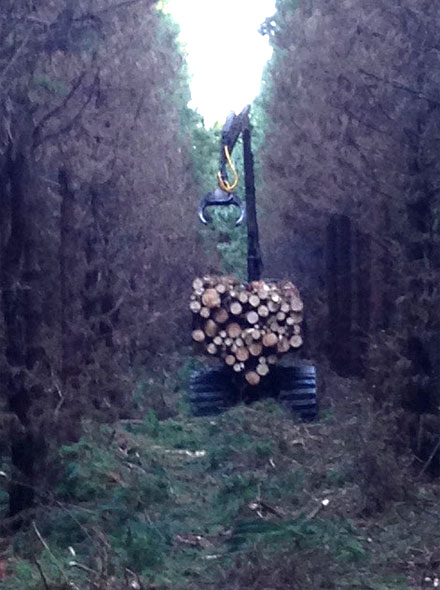
Setting the political issues aside, the logging industry can be viewed in a completely different light. Whanganui-based Hickford Logging is just an 8-man band at the coalface harvesting a 260-hectare pine forest in the steep hills inland from Maxwell, yet an entire community feasts off their labour. Source: New Zealand Herald
The expected 30-month harvest began in November last year with Dave Hickford and his crew working in conjunction with the Forest Management New Zealand (FMNZ) team to formulate a harvest plan.
Once up and running the small 8-man crew hit top gear felling, stacking and preparing a stockpile of 10-12 truck and trailer loads a day for transport to Port Taranaki in New Plymouth where the logs are shipped to various international markets throughout the world.
But before owners Dave and Debbie Hickford pay themselves, at least NZ$9000 a day in running costs must be forked out to keep the harvest going and alongside that is the myriad of industries flying off the coat tails.
“Debbie is a vital part of the business not only paying all the bills and doing the admin work, but she is also a registered nurse so does all the annual health checks and random drug tests,” Mr Hickford said.
FMNZ staff and their families overseeing the operation, the logging truck companies, their drivers and families, the many service industries in town ensuring Hickford Logging’s equipment runs smoothly, the roading contractors maintaining the stretch of road leading up to the forest and the nearby Maxwell Quarry that supplies the material to keep the road open.
The forest, planted some 28-years ago by Waverley farmer and forestry entrepreneur Roger Dickie, is at the end of Rangitatau West Road. But even though the last few kilometres is still part of the South Taranaki District Council legal road, maintenance of the stretch has been thrust upon the owners.
For the duration of the 30-month harvest many of these supporting industries will come to rely on Hickford Logging’s dedication at the coalface.
Dave Hickford reckons the political and environmental issues aside, finding skilled staff was the major problem facing the industry.
Harvesting Whanganui’s wall of wood in the next 20 years is set to provide hundreds of jobs and millions of dollars in income.
Whanganui’s available forestry cut is set to triple over the next two decades. However, Mr Hickford seriously doubts the five or six logging companies in and around Whanganui will be enough to cope with the job.
“We have one bigger contractor here and four or five smaller crews and I really think we will struggle to find enough skilled staff to cope,” Mr Hickford said.
He has been working in the bush since he was 15 and for the past five years has operated his own logging company.
At 41, he has a few years ahead of himself in what is an extremely demanding industry.
“It’s (logging) not for everyone and takes a special type of person. I have a good crew, including my hauler driver Gavin Bladwin who has been with me four of the five years I’ve been out on my own. My faller, however, turns 65 at the end of the year and is set to retire. At the other end of the scale is a young guy I have trained myself and he’s already got various tickets and is a very good worker – all my crew are solid workers.”
The harvest site is knee deep in mud, the terrain is extremley steep with the camp site at 460-feet above sea level.
Snow was excpected to slow production this week.
The machinery is large with more than enough horse power to haul 9-tonne logs from the depths of the gullies to the hilltop loading area.
Hickford Logging operates a 58-tonne hauler, a high-powered bulldozer anchoring the backline and massive tree stumps from a previous cut the steadiers at the other end.
A skidder drags logs from the hauler to the processor which strips the limbs from the main trunk and cuts them to length for export.
Another digger stacks the logs and loads the truck and trailers as they come and go 10 to12 times a day, often starting at 4.30am.
To run all the machinery an 1800-litre diesel tank is refilled every second day, while countless numbers of empty 20-litre oil containers are stacked ready for dumping several times a week.
“Experience is key on this job and safety is paramount. But technology is helping. For instance these days the hauler has a video camera fitted just above the grappler, so the operator can see the felled logs. He can grab the logs and haul them up from the bottom of the gully without us having to send someone down.”
Mr Hickford said workers were acutely aware of safety given it was their lives at stake.
“It can only take one moment of inattention and your gone, you don’t get too many second chances. Necomers to the industry need to be aware of this and while there is an industry organisation training staff, I’m not sure starting in the classroom at 9am and leaving at 2pm gives a true impression of what logging is about.
“It involves long, hard days in difficult and dangerous surrounding. It takes a very special type of person, the person who loves the outdoors, hunting and hard yakka. It can actually be a very rewarding job and the pay’s not too bad.”







